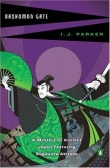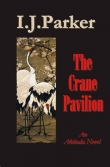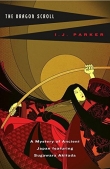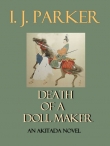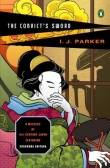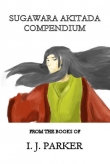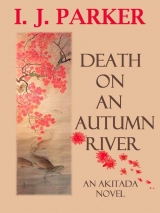
Текст книги "Death on an Autumn River "
Автор книги: Ingrid J. Parker
Жанр:
Исторические детективы
сообщить о нарушении
Текущая страница: 19 (всего у книги 19 страниц)
“Yes. He wished for another boy.”
An heir for the Sugawara name. If they had another son, Akitada hoped he would be a better father to him than he had been to Yori.” His happiness faded as he thought of that other father who had caused his son’s death by wanting the best for him. He felt afraid.
The End
Historical Note
The time of Death on an Autumn River is 1024, nearing the end of the Heian era that predated the period of shoguns and samurai warriors. Though there certainly were wars and warriors, life was more peaceful than in later centuries. The ruler was an emperor and the government was centralized in the capital Heian-Kyo (later Kyoto) but reached across the land via provincial administrations and a well-organized transport system. Most customs and institutions were patterned after those in T’ang China, but contact with foreign countries had been broken off completely in previous centuries, and what foreign trade there was again was still severely controlled.
Japanese officialdom dominated every aspect of the people’s lives, but it was no longer in the hands of the best and brightest as in China. It had passed into the control of a single family of the Fujiwara clan. Through marriage politics, senior Fujiwara officials held all the highest positions. They became the fathers-in-law, uncles, grandfathers, and cousins of ruling emperors. By the eleventh century, they encouraged the early abdication of emperors in order to place another, easily controlled, child on the throne. Perhaps the most powerful man of the time was Chancellor Fujiwara Michinaga, who had ruled for many years, either as chancellor or as the father or grandfather of chancellors, empresses, and emperors. By 1024, he lived retired in the Byodo-in, his palace on the Uji River.
The capital was connected to the provinces via a system of roads with post stations and barriers. All travel could be checked on the highways and along river and sea routes. The most important of these rivers was the Yodo because it connected the capital to the Inland Sea, which in turn linked the Western Provinces and Kyushu with the central government. The Yodo also connected with the Uji River, a tributary that came from Biwa Lake and the North-Eastern provinces. Both boats and sea-going vessels carried people and goods to and from the capital. People traveled the Yodo to engage in business, make pilgrimages, and pursue pleasure, sometimes combining them. Famous shrines and temples were on the route, as were port cities and the pleasure quarters of river villages.
Ocean-going vessels of the period resembled the deep-bottomed Chinese junks. They had huge square sails as well as oars and carried goods from the provinces and from foreign countries to the port of Naniwa. This former capital and major port at the mouth of the Yodo River had silted up by the eleventh century, and several other ports developed along the coastline, but the Yodo River continued to play its role.
Because of storms, sea travel was uncertain and wrecks were common. In addition, pirates roamed the Inland Sea. In the tenth century, Fujiwara Sumitomo, a local nobleman with aspirations and a fleet of several hundred ships, raided commercial ships and those carrying tax tribute. Subduing Sumitomo was costly for the government, and in later years, it tended to close its eyes to more modest depredations.
A number of the river towns specialized in the sex trade. Eguchi, the town in this novel, lay near the mouth of the river and was one of the most important of these. According to Janet R. Goodwin’s Selling Songs and Smiles: The Sex Trade in Heian and Kamakura Japan, attitudes toward prostitution were on the whole tolerant during this time. Distinctions were made between asobi, entertainers who also engaged in sexual relations, and yahochi, who seem to have been ordinary streetwalkers. No doubt, both types flourished in the river towns. Accounts in the diaries of noblemen of the time speak frequently of pleasure cruises from the capital to Eguchi and other towns. They mention local courtesans and reigning beauties (choja) by name.
Little is known about the administration of Settsu province during this time. It would have had a provincial capital and a governor, as well as prefects in the various districts. All provinces had police forces by this time. Military protection for the officials and their headquarters also existed, but the ranks of the guard were filled with local warriors. The central government appointed governors and assistant governors from among the ranking nobility. District officials came from among the local landowners and frequently served a lifetime, a fact that greatly contributed to the rising power of the provincial warrior class. In addition, there were hundreds of irregular appointees with or without noble rank. Their numbers and ranks were carefully fixed by the intricate bureaucratic system. All officials were annually evaluated. Their primary duties involved collection of taxes, keeping the peace, and enforcing laws. Judges worked in conjunction with the provincial administration. Possibly, sentences were harsher the farther crimes occurred from the capital, but executions were still uncommon. The most serious crimes were punishable by exile.
In the centuries before Japan closed its borders to foreigners, both Chinese and Korean immigrants had been made welcome and settled in the country. Their knowledge of the Chinese language and literature, of Buddhist practices, and of the arts made them respected members of Japanese society. Professor Otomo is such a descendant of earlier immigrants, and like many of them, an academic.
By the beginning of the eleventh century, trade with China and Korea began again on a small scale with special permits being extended to certain merchants only. The court nobles controlled all imports. The taste of the highest-ranking nobles for foreign art and the craving of the powerful temples for Buddhist religious objects made them the prime consumers of such goods, and permits were issued frequently.
The two religions practiced in Japan at the time, Buddhism and Shinto, coexisted amicably, sometimes within the same temple or sacred place. This collaboration was especially useful in the case of death, because Shinto abhorred contact with the dead and required elaborate purification rites before worshipping at a shrine. Hence the taboo tags worn by Akitada after Seimei’s death. The funeral rites for Seimei were carried out by Buddhist priests.
Finally, the figure of the ninja-like spy Saburo may seem an anachronism this early in Japanese history, but toward the end of the Heian period, temples and monasteries began military training for monks and lay soldiers in order to protect their lands and defend themselves against rival monasteries. It was in this context that the first “spy” stories appeared.
Contact Information
For more information, please visit I. J. Parker’s web site:
http://www.ijparker.com
To order the author’s books click on:
Amazon
